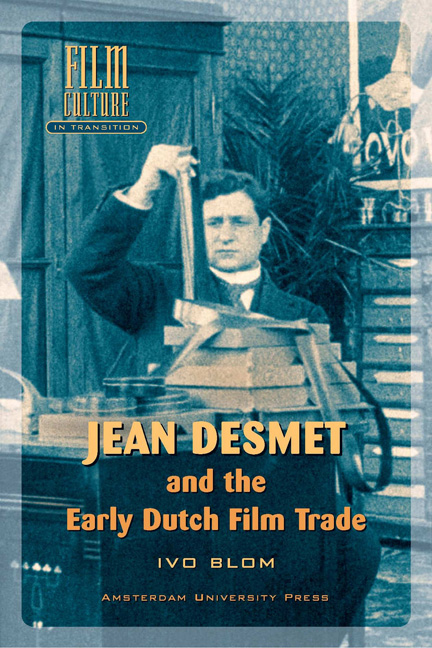Book contents
- Frontmatter
- Dedication
- Contents
- Preface
- Abbreviations, Unidentified Films and Historical Currencies
- Introduction
- I La Comète Belge: Jean Desmet’s Travelling Cinema, The Imperial Bio (1907-1910)
- II In The Beginning…: Film Distribution in the Netherlands Before Desmet
- III Gold Rush: In the Throes of Cinema Mania (1909-1914)
- IV Film Market Europe: Buying Films Abroad (1910-1914)
- V White Slave Girls and German Kultur: Film Rental and Distribution Strategies in the Netherlands (1910-1914)
- VI Onésime et Son Collègue: Competition (1910-1914)
- VII Das Ende vom Lied: The Impact of the First World War (1914-1916)
- VIII Quo Vadis?: Desmet’s Film Rental and Cinema Operation During the Great War (1914-1916)
- IX Afterlife: A New Career and the Beginning of a Collection
- X In Retrospect: Jean Desmet’s Place in Film History
- Notes
- Bibliography
- Photo Credits
- Film Culture in Transition
- Index of Film Titles
- General Index
III - Gold Rush: In the Throes of Cinema Mania (1909-1914)
Published online by Cambridge University Press: 14 January 2021
- Frontmatter
- Dedication
- Contents
- Preface
- Abbreviations, Unidentified Films and Historical Currencies
- Introduction
- I La Comète Belge: Jean Desmet’s Travelling Cinema, The Imperial Bio (1907-1910)
- II In The Beginning…: Film Distribution in the Netherlands Before Desmet
- III Gold Rush: In the Throes of Cinema Mania (1909-1914)
- IV Film Market Europe: Buying Films Abroad (1910-1914)
- V White Slave Girls and German Kultur: Film Rental and Distribution Strategies in the Netherlands (1910-1914)
- VI Onésime et Son Collègue: Competition (1910-1914)
- VII Das Ende vom Lied: The Impact of the First World War (1914-1916)
- VIII Quo Vadis?: Desmet’s Film Rental and Cinema Operation During the Great War (1914-1916)
- IX Afterlife: A New Career and the Beginning of a Collection
- X In Retrospect: Jean Desmet’s Place in Film History
- Notes
- Bibliography
- Photo Credits
- Film Culture in Transition
- Index of Film Titles
- General Index
Summary
Although you may not yet have read about it in the press, and although the public health inspector has so far refrained from becoming involved, I have absolutely no reason to conceal from you that here we have been infected for some time by a disease that is claiming more victims by the day. I hear that in medical circles they are calling it cinema fever.
In 1909, Jean Desmet transferred from the fairground to permanent cinema. It was a move that was typical of the times, not just in the Netherlands, but also in the world at large. Permanent cinemas reached countries such as France, Germany and Great Britain earlier than the Netherlands and developed on a larger scale. The Netherlands caught ‘cinema fever’ from abroad, but the bug did not spread wholesale, and Amsterdam was not infected immediately. Together with members of his family, Desmet began in 1909 to create one of the first (if not the first) cinema chains. In both Rotterdam and Amsterdam, where his cinemas were both named Cinema Parisien, he was one of the first to open a permanent cinema. Although not the first person to set up a permanent motion-picture theatre, he undoubtedly spearheaded the new trend. In both Rotterdam and Amsterdam, the number of permanent cinemas increased explosively from this point onwards, peaking in the former in 1910 and in the latter in 1912.
With the opening of the Cinema Palace in 1912, Desmet was also involved at the onset of a differentiation between smaller theatres catering to neighbourhoods and larger luxury theatres in city-centre shopping streets and entertainment districts. Both the breakthrough of permanent cinemas and their classification according to type were due in large measure to changes in film programming consequent upon the arrival and success of the long film, which staked out a position for itself within film performances as the ‘main feature’. Another factor contributing to subdivision was the increasing competition among cinema owners, and the legitimisation of film and cinema as more than mere fairground fun. While it is true that there was little difference between the programmes of both kinds of cinema, the degree to which these programmes were up to date could vary enormously, as could the performance environment. This produced different kinds of performances.
- Type
- Chapter
- Information
- Jean Desmet and the Early Dutch Film Trade , pp. 89 - 132Publisher: Amsterdam University PressPrint publication year: 2003



